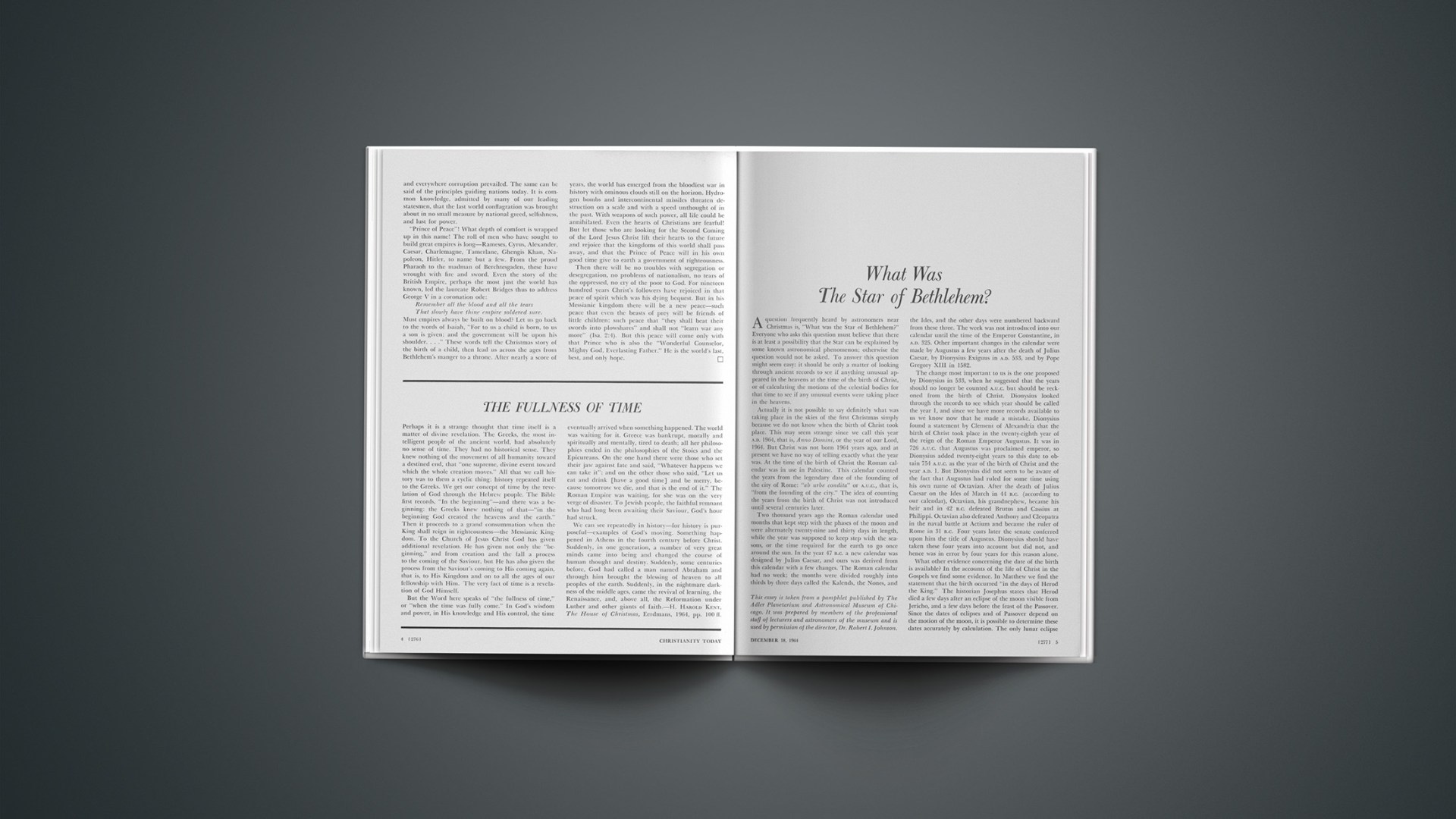A question frequently heard by astronomers near Christmas is, “What was the Star of Bethlehem?” Everyone who asks this question must believe that there is at least a possibility that the Star can be explained by some known astronomical phenomenon; otherwise the question would not be asked. To answer this question might seem easy: it should be only a matter of looking through ancient records to see if anything unusual appeared in the heavens at the time of the birth of Christ, or of calculating the motions of the celestial bodies for that time to see if any unusual events were taking place in the heavens.
Actually it is not possible to say definitely what was taking place in the skies of the first Christmas simply because we do not know when the birth of Christ took place. This may seem strange since we call this year A.D. 1964, that is, Anno Domini, or the year of our Lord, 1964. But Christ was not born 1964 years ago, and at present we have no way of telling exactly what the year was. At the time of the birth of Christ the Roman calendar was in use in Palestine. This calendar counted the years from the legendary date of the founding of the city of Rome: “ab urbe condita” or A.U.C., that is, “from the founding of the city.” The idea of counting the years from the birth of Christ was not introduced until several centuries later.
Two thousand years ago the Roman calendar used months that kept step with the phases of the moon and were alternately twenty-nine and thirty days in length, while the year was supposed to keep step with the seasons, or the time required for the earth to go once around the sun. In the year 47 B.C. a new calendar was designed by Julius Caesar, and ours was derived from this calendar with a few changes. The Roman calendar had no week; the months were divided roughly into thirds by three days called the Kalends, the Nones, and the Ides, and the other days were numbered backward from these three. The week was not introduced into our calendar until the time of the Emperor Constantine, in A.D. 325. Other important changes in the calendar were made by Augustus a few years after the death of Julius Caesar, by Dionysius Exiguus in A.D. 533, and by Pope Gregory XIII in 1582.
The change most important to us is the one proposed by Dionysius in 533, when he suggested that the years should no longer be counted A.U.C. but should be reckoned from the birth of Christ. Dionysius looked through the records to see which year should be called the year 1, and since we have more records available to us we know now that he made a mistake. Dionysius found a statement by Clement of Alexandria that the birth of Christ took place in the twenty-eighth year of the reign of the Roman Emperor Augustus. It was in 726 A.U.C. that Augustus was proclaimed emperor, so Dionysius added twenty-eight years to this date to obtain 754 A.U.C. as the year of the birth of Christ and the year A.D. 1. But Dionysius did not seem to be aware of the fact that Augustus had ruled for some time using his own name of Octavian. After the death of Julius Caesar on the Ides of March in 44 B.C. (according to our calendar), Octavian, his grandnephew, became his heir and in 42 B.C. defeated Brutus and Cassius at Philippi. Octavian also defeated Anthony and Cleopatra in the naval battle at Actium and became the ruler of Rome in 31 B.C. Four years later the senate conferred upon him the title of Augustus. Dionysius should have taken these four years into account but did not, and hence was in error by four years for this reason alone.
What other evidence concerning the date of the birth is available? In the accounts of the life of Christ in the Gospels we find some evidence. In Matthew we find the statement that the birth occurred “in the days of Herod the King.” The historian Josephus states that Herod died a few days after an eclipse of the moon visible from Jericho, and a few days before the feast of the Passover. Since the dates of eclipses and of Passover depend on the motion of the moon, it is possible to determine these dates accurately by calculation. The only lunar eclipse that satisfies the necessary conditions took place on March 13, 4 B.C. The Passover was celebrated on April 12 of that year, so Herod must have died at some time near April 1, 4 B.C., and Christ must have been born before this date, possibly a few years before.
Another clue is found in Luke, where we read of the reason Joseph and Mary went to Bethlehem and why Bethlehem was so crowded that “there was no room for them in the inn.” This was because taxes were being collected, and everyone had been ordered to return to his native town or city for this purpose: “all went to be taxed, everyone into his own city.” If we knew just when this tax collection was made we would know the date of the birth of Christ, but unfortunately there is no exact record. No one had any accurate idea until about twenty years ago, when some archaeologists working in Ankara, Turkey, uncovered an inscription giving a list of the years in which orders were issued for tax collections. Three of these are 28 B.C., 8 B.C., and A.D. 14. Others are listed, but none falls between 28 B.C. and A.D. 14 except 8 B.C. Clearly, 28 B.C. is too early and A.D. 14 is too late, so that the tax collection of 8 B.C. appears to be the one with which we are concerned. This seems to indicate that the birth of Christ may have taken place as early as 8 B.C. But we must remember that this was the year in which the orders were issued, and it is easy to see how with the slow travel and poor communications of those days the actual collection of taxes might have been delayed for a year or two in countries like Palestine, near the edge of the Roman empire. Thus the year of the birth may well have been 7 B.C. or even 6 B.C. Most students of the question agree upon these two years as the most likely ones.
A Clue To The Season
We cannot be sure of the exact year of the birth of Christ, and we have but one slender clue as to the season of the year. This is the statement in Luke that there were “shepherds abiding in the field, keeping watch over their flock by night.” Shepherds do not ordinarily watch their flocks at night except during the spring, the season when the lambs are born; and so it would seem that the birth of Christ may have taken place in the spring. The early Christians celebrated the Nativity on January 6, together with Epiphany and the Baptism. This was very close to the Roman feast of the Saturnalia, which marked the first day of winter, then December 25. Later Christmas or the Nativity was separated from Epiphany and moved back to coincide with and take the place of the pagan festival of the Saturnalia. Although the Saturnalia is often thought of as a period of riotous celebration, it was originally a more sober time of good feeling.
Now that we know the approximate time, let us look for the answer to our question: “What was the Star of Bethlehem?” Many suggestions have been made. One is that the Star was nothing more than an exceptionally bright shooting star or meteor, what is called a fireball or bolide. Sometimes these are bright enough to be seen in full daylight, and when seen in the night sky they are very spectacular objects. The ordinary meteor is a very small object, usually no larger than the head of a pin, that strikes the earth’s atmosphere at such a high speed that the friction with the air heats it up until it shines. In the brief interval of a second or two the particle is entirely consumed, but while this is happening we see the object as a bright star-like point streaking across the sky.
Larger meteors, weighing perhaps hundreds of pounds or several tons, put on a more exciting show, sometimes giving more light than the full moon. While these are rather rare, anyone who lives far from cities and who spends a considerable amount of time out of doors after dark is likely to see several of them in a lifetime. Such an object would not be considered extremely unusual, and it would seem also that the Star of Bethlehem must have been something less ephemeral. So let us search further for some explanation that seems more likely.
Was The Star A Comet?
Comets immediately come to mind, since even today they have a great effect upon the emotions of the superstitious and the ignorant. Comets move in regular orbits around the sun, but these orbits are usually not nearly so circular as those of the planets. The orbits of most comets are long narrow ellipses, with the sun near one end of the ellipse. When a comet is far from the sun, it cannot be seen even with large telescopes; but as it approaches the sun it becomes brighter and may grow a long tail composed of very thin gases and very fine dust. If when the comet comes close to the sun it also comes close to the earth, it will be a very spectacular object in the night sky. Faint comets are not unusual, as many as fourteen having been observed in a single year; but really bright ones are unusual, appearing only a few times each century. No bright comet has been seen in the night sky since the last appearance of Halley’s Comet in 1910. Two other really bright comets have been seen in the night sky during this century, but these were not visible to observers in the northern hemisphere.
Although bright comets are sometimes visible for months or even a few years in great telescopes, they are visible to the unaided eye for a few weeks at most. At these times they can be seen rising and setting like the sun, moon, and stars, slowly changing their positions among the stars from night to night. A spectacular comet attracts so much attention that its appearance was likely to be recorded in many places in ancient times. As an example we may take Halley’s Comet, which appears once every seventy-seven years since it goes around the sun once in that period. Records of every appearance of this comet back to 240 B.C. have been found in Europe, China, or Japan. When we search these same records to see if a bright comet was seen at the time of the birth of Christ, we find that one (Halley’s) was seen in 11 B.C. and another in 4 B.C., with none between these dates. We have already seen that 4 B.C. is too late while 11 B.C. is too early, and may thus dismiss comets as a possible explanation of the Star. We need not consider the possibility that a comet did appear at the right time but was not recorded, because such an apparition was almost universally held to be an evil omen, heralding the coming of war, pestilence, or famine, and never a sign of something good.
Every few years at irregular intervals, a bright nova or “new star” appears suddenly in the sky, and it has often been suggested that such an object might have been the Star of Bethlehem. A nova is really not a new star but a faint star that very suddenly, in a few hours, becomes much brighter. Some sort of explosion takes place; the star blows off its outer layers and may increase its brightness many thousands of times in a day or two. Sometimes these objects become bright enough to be seen in full daylight, only to fade away in a few weeks or months so that telescopes are required to see them. About a dozen novae are discovered somewhere in the universe each year, but few of these are near enough to be seen without telescopes even when at their brightest. There are two classes of novae, ordinary ones that at maximum give off about 25,000 times as much light as the sun, and supernovae, which are 100,000,000 times as luminous as the sun.
If a star at a distance of 100 light years were to become a supernova, it would be brighter than the full moon. Two of these that were close enough to be very conspicuous are recorded: one appeared in 1572 and was bright enough to be seen in full daylight; the other, seen in 1604, was brighter than any object in the night sky except Venus and the moon, and remained visible to the unaided eye for seventeen months. The nova of 1604 was observed by Kepler, one of the greatest of all astronomers, and he was the first to suggest that the Star of Bethlehem might have been such an object. We cannot find any record of the appearance of a nova at any time near the birth of Christ, and we should expect such an event to have been recorded. This does not mean, however, that we must discard this explanation of the Star.
Before we consider another possibility, let us see just what we know about the Star itself. It is mentioned in only one chapter in the Gospels, Matthew 2, where we read:
Now when Jesus was born in Bethlehem of Judaea in the days of Herod the king, behold, there came wise men from the east to Jerusalem,
Saying, Where is he that is born King of the Jews? for we have seen his star in the east, and are come to worship him.
When Herod the king had heard these things, he was troubled, and all Jerusalem with him.
And when he had gathered all the chief priests and scribes of the people together, he demanded of them where Christ should be born.
And they said unto him, In Bethlehem of Judaea: for thus it is written by the prophet,
And thou Bethlehem, in the land of Juda, art not the least among the princes of Juda: for out of thee shall come a Governor, that shall rule my people Israel.
Then Herod, when he had privily called the wise men, inquired of them diligently what time the star appeared.
And he sent them to Bethlehem, and said, Go and search diligently for the young child; and when ye have found him, bring me word again, that I may come and worship him also.
When they had heard the king, they departed; and, lo, the star, which they saw in the east, went before them, till it came and stood over where the young child was.
When they saw the star, they rejoiced with exceeding great joy.
And when they were come into the house, they saw the young child with Mary his mother, and fell down, and worshipped him; and when they had opened their treasures, they presented unto him gifts; gold, and frankincense, and myrrh.
Nowhere else in the Bible is the Star mentioned, and even here the word is used but four times. Few people seem to realize this, and we find many inaccuracies and embellishments in the story as it is told and pictured today. How often do we see in advertisements and on Christmas cards pictures of the shepherds with the Star of Bethlehem in the sky, even though the shepherds never saw the Star. We see pictures of the shepherds and the Wise Men visiting the Christ-child together, although they never did so. Other pictures show the Wise Men worshiping the Child as he lay in the manger, but Matthew distinctly states that they entered a house to visit him. Although the Scriptures do not say how many Wise Men there were, we all are taught that there were three; and somewhere during the centuries names have been supplied for them!
Only The Wise Men Saw
Brief as the mention of the Star is, and despite the fact that no description whatever is given of it, we find an extremely important clue in the lines quoted above: no one but the Wise Men saw the Star. When they told Herod of it he had obviously not seen it or even heard of it, for he “inquired diligently what time the star appeared.” Obviously no spectacular object had been seen in the heavens, for if it had, no one, especially Herod, would have been ignorant of it. The shepherds saw the angel of the Lord but not the Star. Only the Wise Men saw it. We must remember that the word “star” was often used in those days in a somewhat different way and with a broader meaning than the one with which we are familiar today. Then the word was used for almost any object in the sky, whatever its nature, and sometimes even for events in the heavens. Since no one else saw the Star, we must search, not for some spectacular object in the sky visible to everyone, but rather for something that must have been visible to anyone who looked at the sky, but that was thought to be of especial significance only by the Wise Men.
Before doing this we must know more about these men—who they were, where they came from, what they thought and believed. “Wise men from the east” probably means from the part of the world we call Persia. We have another name for these men: the Magi. From this come our words magic and magician, and the Magi were magicians and necromancers. They were priests of Zoroaster and believers in astrology. Today in the scientific world astrology is thoroughly discredited and condemned, and no scientist has any faith in its teachings. Astrology seems to have originated among the ancient Babylonians as an important part of their religion, although few of those who practice astrology today realize that they are practicing an ancient pagan religion. But we must think of things as they were 2,000 years ago to understand the Wise Men.
They believed that the heavenly bodies actually influenced the lives of human beings and had worked out a very complex scheme by which it was supposed that this influence could be determined beforehand. The sky was divided into imaginary regions (the stars themselves have nothing to do with astrology even today) that were supposed to control the various parts of the earth, various races, different parts of the body, and so on. The influence of the regions was supposed to be determined partly by the arrangement within them of the seven ancient planets: Mercury, Venus, Mars, Jupiter, Saturn, and the sun and the moon. These seven objects move about among the apparently fixed stars, and any unusual arrangement of them was supposed to portend some unusual event. The Wise Men were familiar with the ancient prophecies concerning the coming of a King, whose birth was to be preceded by a sign in the sky. Indeed, this was part of the religion of Zoroaster, and so we would expect the Magi to be watching the heavens for such a sign.
Signs In The Heavens
What events in the heavens of astrological significance were taking place in the years we have chosen as those in which the birth of Christ probably occurred? When Kepler first saw the great nova of 1604, he was watching something else unusual, a close grouping of the planets Mars and Jupiter and Saturn. Jupiter and Saturn are the slowest moving of the planets, Jupiter requiring almost twelve and Saturn nearly thirty years to go once around the sky as they move eastward among the stars. As they follow these motions, ordinarily Jupiter passes Saturn once each twenty years. When one planet passes another they are said to be in conjunction, even though one may be at a considerable distance north or south of the other when they pass. Near the end of 1603 there was a conjunction of Jupiter and Saturn, and during the following months Jupiter slowly moved ahead of Saturn. Before the two planets were very far apart Mars passed them both, near the beginning of October, 1604. While the three planets thus stood close together on October 10, 1604, the bright nova mentioned earlier appeared almost in their midst. It must have been a most striking sight, and it set Kepler to thinking about the Star of Bethlehem.
He calculated back to see when this close grouping of Mars, Jupiter, and Saturn had taken place before and found that it happens once each 805 years, and that it must have been seen in 6 B.C.! In 6 B.C. the three planets were close together in Pisces, the Fishes, which the ancient astrologers called the House of the Hebrews, since celestial events taking place there were supposed to be of particular importance to the Jews. Also they believed that Saturn ruled over the destinies of the Jews, so that they had two good reasons for believing that this extremely rare grouping of the planets portended some event of extreme importance about to take place among the Jews. Since the Wise Men were watching for a sign of the coming of the King, it is easy to think that they might have accepted this as the sign, and it may well have been this that started them on their journey to Jerusalem. This celestial event was of great significance to the Magi but would have attracted little attention from the casual observer of the heavens.
Other important events had been taking place in the same part of the sky a little earlier. Jupiter and Saturn (and the other planets as well) do not move steadily eastward among the stars but sometimes appear to reverse their motions and go westward for a few months. If this happens at just the right time after Jupiter has passed Saturn, Jupiter will pass Saturn a second time as it reverses its motion, and a third time when it starts forward again, giving three conjunctions in a few months instead of the usual one each twenty years. This happened in Pisces, on May 29, September 29, and December 4 of 7 B.C. Also, in the spring of 6 B.C., after Mars had moved away from Jupiter and Saturn but while they were still fairly close together, Venus passed the two planets, forming another close and unusual grouping visible in the morning sky.
Thus the Wise Men saw several rare and, to them, very significant events taking place in the House of the Hebrews. First, during 7 B.C. the triple conjunction of Jupiter and Saturn that occurs only once each 125 years. Next, the close grouping of Mars, Jupiter, and Saturn early in 6 B.C., which occurs only once in 805 years and which must have been an unheard-of event to them. As has been suggested above, this was probably the sign that started them on their long journey which ended in Bethlehem. If so, while they were traveling, the third close grouping of Venus, Jupiter, and Saturn took place. Kepler always believed that another nova had appeared at about the time of the end of the journey; but as we have seen, we have no evidence of this.
Thus we see some possible explanations of the Star that astronomers have to offer: a brilliant meteor or fireball, a comet, a nova or new star, and some unusual groupings of the planets. Of these the last appears to be the most likely. But there is another possibility, or perhaps it would be better to say another point of view. Many of us believe the Star to have been a miracle, and thus utterly incapable of explanation. The important thing is not the explanation of the Star but the Christmas story itself, and the simple truths which it presents. Especially during this period of international tension and apprehension, with its possibility of far more devastating war than ever before, we find the world badly in need of the principles of good will and brotherly love so that peace may be preserved.










